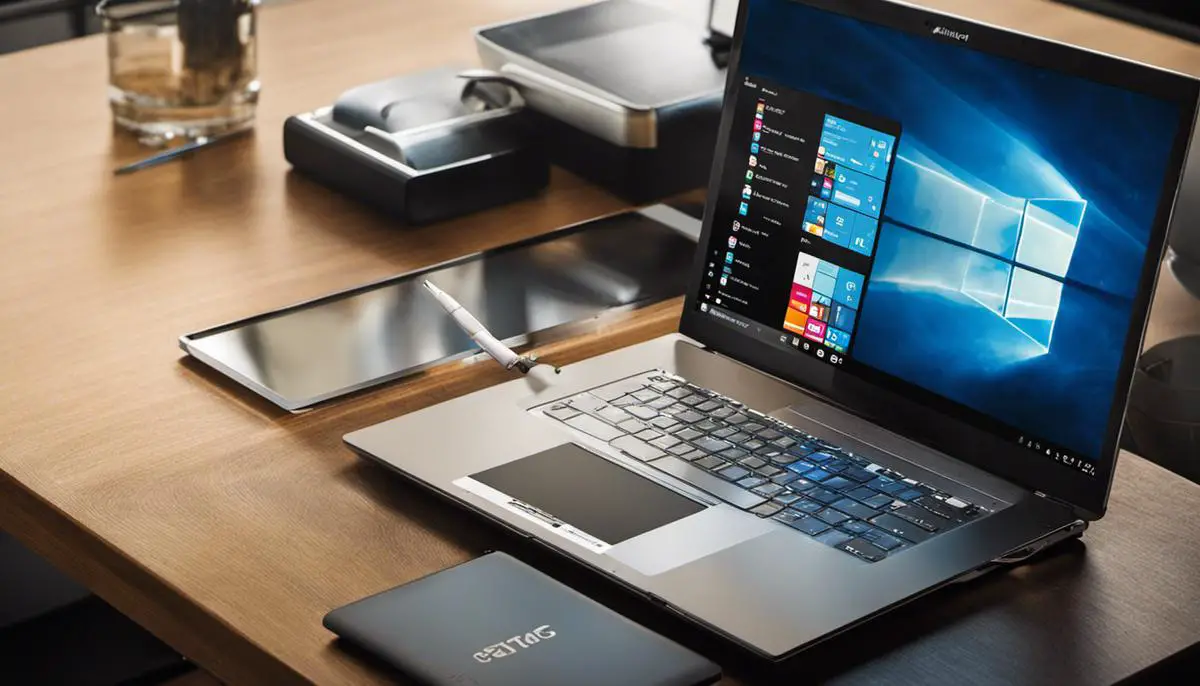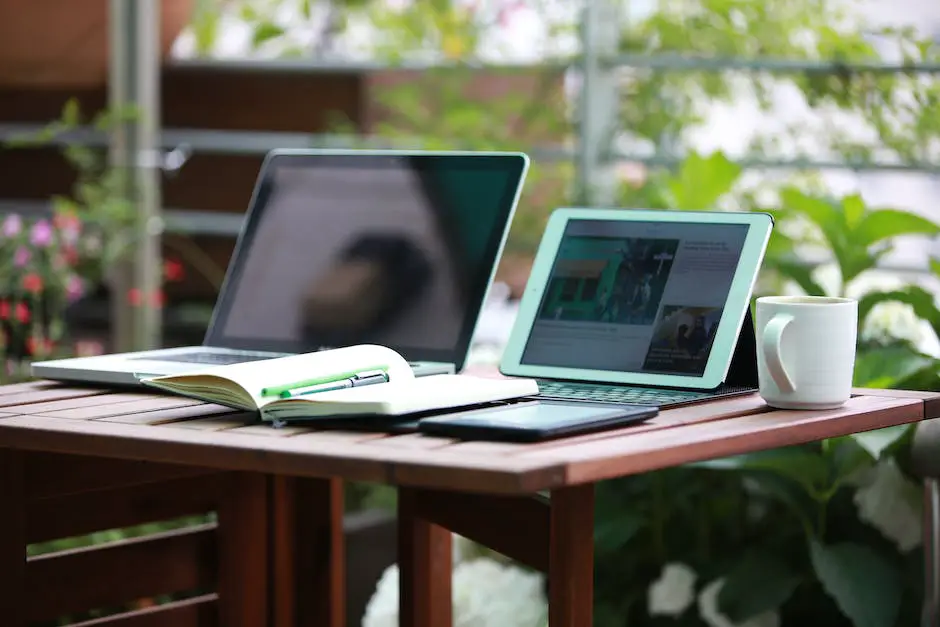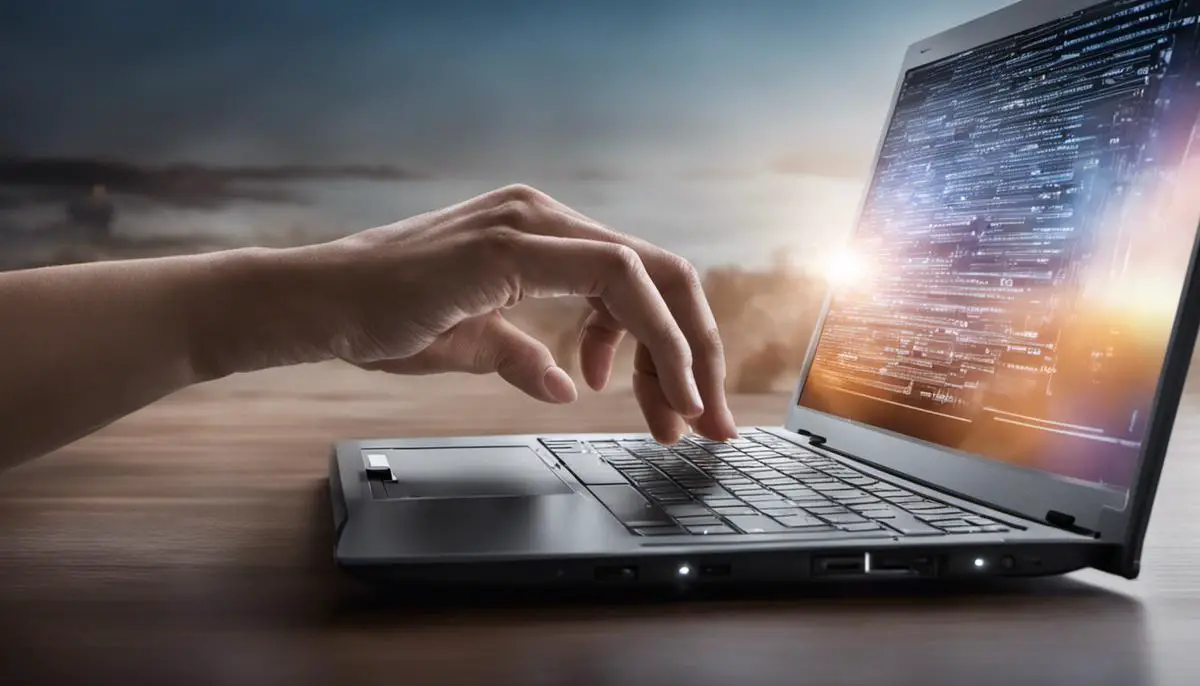In the realm of mobile computing, the emergence of touchscreen laptops has reshaped the dynamics of user interaction with computers, blending the convenience of touch interfaces with the power of traditional laptops.
This article sheds light on the multifaceted aspect of touchscreen laptops, starting with a brief understanding of what they are, their working mechanisms, and their pros and cons.
Wading into the history and evolution of touchscreen technology, we’ll explore different types that have sprung up over the years, such as capacitive and resistive touchscreens. Furthermore, we’ll delve into the profound impact of touchscreen technology on the overall user interface experience.
As a dedicated tech enthusiast and a professional in the field, I’ve experienced firsthand the transformative impact of touchscreen laptops on our day-to-day computing tasks. Integrating the tactile intuitiveness of a smartphone with the robust capabilities of a traditional laptop, these marvels of technology are rewriting the rules of user engagement.
Join me as we navigate the versatile landscape of these innovative machines, understand their workings, and discover ways to maximize their potential.
Understanding Touchscreen Laptops
Getting Acquainted with Touchscreen Laptops
Ever found yourself instinctively reaching out to swipe or tap your laptop screen—especially after spending some time on your smartphone? Well, touchscreen laptops are here to make those instincts second nature.
In simple terms, these are portable computers that put the control literally at your fingertips. Democratizing the user experience, they let you touch, pinch, or swipe directly on the screen, saying goodbye to the exclusive dependence on a mouse or touchpad – a fresh twist to the way we’re used to interacting with our laptops.
So, let’s delve deeper into this tactile technology that’s changing the way we compute.
Related: Lenovo Yoga 520 Touch Screen Not Working (Fixes)
How Does Your Touchscreen Laptop Respond to Touch?
Touchscreen laptops are all about bringing the user front and center – simplifying the way you interact with your digital world. So, how does your touchscreen laptop understand when and where it’s being touched? Fear not, we’re breaking it down in the most digestible way possible.
- Sensors, the unsung heroes: Your touchscreen is more than just a display – it’s a network of sensors. These sensors detect the presence and location of a touch within the display area. So, when you tap, swipe, or scribble away on the screen, it’s these sensors that are working behind the scenes to bring your commands to life.
- Types of Touchscreens: There are two big players in the touchscreen game – capacitive and resistive.
- Capacitive Touchscreens: These are the high-end types commonly found in modern smartphones and premium laptops. They work using the electrical charges that are naturally present in your body. When your finger makes contact with the screen, it disrupts the device’s electric field, letting the device know exactly where you’ve touched. The best part? They support multi-touch, so you can pinch-to-zoom to your heart’s content.
- Resistive Touchscreens: These screens rely on pressure. Found in devices like point-of-sale terminals or in-flight entertainment systems, resistive touchscreens have two flexible layers with an air gap in between. Apply some pressure, and these layers touch to complete an electrical circuit, signaling the device to respond.
So, the next time you’re effortlessly tapping away on your touchscreen laptop, spare a thought for the impressive tech working tirelessly beneath your fingertips.
Advantages and Disadvantages of Touchscreen Laptops
Touchscreen laptops offer a more intuitive and engaging user experience as they combine the convenience of touch controls with the full capabilities of a laptop.
They come in handy for creative tasks such as drawing, editing photos or videos, and taking handwritten notes.
However, there are disadvantages as well. Touchscreen laptops can consume more battery power, and their screens may catch smudges and fingerprints, affecting visibility.
Moreover, these laptops are often more expensive than their non-touch counterparts.
The Evolution of Touchscreen Technology
The first iteration of the touchscreen technology was in the 1960s by E.A. Johnson, but it didn’t gain much prominence until the 1980s and early 2000s. The introduction of devices like the iPhone, which seamlessly integrated touchscreen technology, paved the way for uplifting user interface designs.
In the laptop space, it was Microsoft’s Windows 8 operating system that assured widespread integration of touchscreen technology in laptops. Ever since its evolution has constantly targeted enhancing the user’s interaction with the device.
The future of touchscreen technology in laptops points toward more fluid interactions and functionality, such as flexible displays and even the removal of the physical keyboard.
One noteworthy technological advancement in this space is the development of haptic touchscreens, which provide tactile feedback to mimic the feeling of pressing physical buttons, taking the touchscreen experience one step ahead.
The Role of Touchscreens in User Interfaces
Touchscreen laptops have dramatically reshaped the landscape of user interface designs. These touch-enabled devices enable direct interaction with the surface of the screen, prompting a redesign of application icons and operating systems to be larger and more touch-friendly.
The use of touchscreens also magnifies the capacity for multitasking thanks to the ability to simultaneously have multiple windows open and the ease of task switching.
Ultimately, the advent and incorporation of touchscreen technology in laptops have revolutionized computing technology and the user interface experience as a whole.
This new method of interaction is more efficient, direct, and intuitive than ever before. However, it’s vital for users to carefully consider their individual requirements and potential limitations before opting for a touchscreen laptop.

Features to Look for in Touchscreen Laptops
Decoding Touchscreen Technology in Laptops
When deliberating on a touchscreen laptop, the functionality and performance of the screen itself is a significant aspect to consider.
Mainly, touchscreen technology comes in two forms: resistive and capacitive.
Resistive touchscreens operate by recognizing pressure put on the display while capacitive screens detect the electrical charge produced by human touch. Capacitive touchscreens have become more desirable due to their ability to perceive multiple touch points simultaneously (thus enabling gesture controls like pinching and zooming), their superior clarity, and their enhanced durability.
Capacitive technology is predominantly the go-to choice for laptops with touchscreen functionality.
Display Quality
When it comes to displays, look for a high-definition (HD) or full high-definition (FHD) screen for sharp, clear images.
Higher-end models may even feature a 4K display for an even better viewing experience. The screen size also matters, with most laptops varying from 13 to 17 inches.
When choosing a screen size, balance your desire for a large, clear display with considerations of weight and portability.
Processing Power
The processor, or CPU, is the heart of the laptop. Powerful processors can handle more tasks simultaneously, run demanding applications more smoothly, and generally provide a more responsive and enjoyable user experience.
A mid-range processor like an Intel Core i5 or AMD Ryzen 5 should be sufficient for most general computing tasks, while a high-end processor like an Intel Core i7 or AMD Ryzen 7 would be necessary for heavy multitasking, gaming, video editing, and other demanding tasks.
RAM and Storage
Random Access Memory (RAM) is another crucial factor. It enables the processor to access data more quickly, which means that having more RAM can cause your system to perform better, especially when it comes to multitasking.
For general use, 8GB of RAM should be sufficient, but heavy users and gamers should consider 16GB or more.
As for storage, Solid State Drives (SSD) are faster and more reliable than traditional Hard Disk Drives (HDD), but also more expensive per GB.
Many users find a compromise with a smaller SSD for the operating system and most frequently used programs, paired with a larger HDD for mass storage.
Battery Life
Battery life is particularly important for users on the go. Several factors affect battery life, including the screen brightness, the efficiency of the processor, and the usage patterns of the user.
Many touchscreen laptops offer between 6-9 hours of battery use. Some premium models offer up to 12 hours or more, but these will also often come with a steeper price tag.
Portability
For those who plan to carry their laptop around often, weight and size are significant factors to consider. Generally, laptops with smaller screens are lighter and more compact.
While a 17-inch laptop might offer a great viewing experience, it could also be quite heavy to haul around.
Understanding Convertible Models
For some users, the advantage of touchscreen laptops is the ability to switch between laptop and tablet modes. This requires a sturdy and reliable hinge.
Look for models with a robust hinge mechanism that allows for 360-degree rotation.
Stylus Compatibility
If you’re someone who finds the use of a stylus in art creation or note-taking beneficial, you must account for pen support when purchasing a touchscreen laptop.
Not every touchscreen is stylus-friendly, and the quality of styluses can greatly differ.
Ensure the laptop you select either comes bundled with a high-quality stylus or is compatible with a top-of-the-range active stylus for an optimal drawing and writing experience.
Also Read: Laptop Display Showdown: Matte versus Glossy Screens

Review and Comparison of Top Touchscreen Laptops
Microsoft Surface Pro 7
When discussing advanced touchscreen laptops, the Microsoft Surface Pro 7 is worth mentioning. With its stunning 12.3″ PixelSense Display capable of delivering a sharp 1824 x 2736 resolution, it stands out among its peers.
Powering this machine is a robust 10th-Gen Intel Core Processor, coupled with a quick-to-access solid-state drive (SSD) that comes in variances ranging from 128GB to a massive 1TB.
Customize your device to suit your computing needs with options for 4GB, 8GB, or 16GB of RAM. Highlighting its advantages, the Surface Pro 7 can seamlessly switch between laptop, studio, and tablet modes, making it an ideal choice for a wide range of tasks.
However, bear in mind that its battery life could be better, offering up to 10.5 hours under typical usage conditions.
HP Spectre x360
The HP Spectre x360 gets high marks for its sleek design and powerful performance. Available in both 13” and 15” models, its micro-edge WLED-backlit touchscreen display is vivid and responsive.
It also features a strong Intel i7-1065G7 Processor and comes with an SSD ranging from 256GB up to 1TB, with 8GB to 16GB of RAM. The device also offers substantial battery life – up to 22 hours for the 13” model.
A potential drawback is its heavier weight, which might be inconvenient for users who are often on the go.
Dell XPS 13
Dell’s XPS 13 is another prime touchscreen laptop in the market. It is best known for its infinity edge display, offering a nearly borderless 13.3″ Full HD touchscreen.
The gadget boasts a 10th Gen Intel Core i7-1065G7 Processor and SSDs from 256GB to 1TB, with 8GB or 16GB of RAM.
One limitation to mention is that the keyboard may not be user-friendly for all individuals due to its small size.
Lenovo Yoga C940
The Lenovo Yoga C940 is a feature-rich touchscreen laptop suitable for both professionals and students. Characterized by a rotating sound bar with Dolby Atmos Speaker System, the device ensures top-quality sound for videos and music.
It is equipped with a 10th Gen Intel Core i7-1065G7 processor and has SSDs from 256GB to 1TB and RAM of 8GB to 16 GB.
Its only significant downside is its expensive price tag.
The Apple MacBook Air
While the Apple MacBook Air might not be a typical touchscreen laptop, its functionality includes supporting Apple’s Sidecar feature which allows an iPad to act as a secondary touchscreen monitor.
The 13” version sports a retina display powered by a potent M1 chip, guaranteeing significantly superior CPU and graphic speeds. It can accommodate an SSD of up to 2TB and has 8GB RAM.
Nevertheless, the unavailability of a traditional touchscreen display might be a drawback for those explicitly seeking a fully integrated touchscreen laptop.

Maintenance and Troubleshooting of Touchscreen Laptops
Looking After Your Touchscreen Laptop
To ensure your touchscreen laptop stays running at its finest and lasts for many years, a bit more care is required from users.
One fundamental aspect of this maintenance is keeping the touchscreen spotless. Allowing dust, dirt, and smudge marks to accumulate disturbs the touch sensitivity and can wear down the screen’s surface over prolonged periods.
Cleaning Touchscreens
For screen cleaning, a microfiber cloth is recommended to gently wipe the surface without the risk of scratching it, since standard cloth or paper towels may be too abrasive.
Additionally, avoid applying harsh chemicals directly on the screen; instead, you can lightly dampen the cloth with distilled water or use a specialized screen cleaning solution.
Calibrating the Touchscreen
Sometimes, touchscreens may lose their calibration, resulting in less responsive or inaccurate touch inputs. Many laptops with touchscreens come with calibration tools in the system settings.
Users can run these tools to recalibrate the touchscreen, improving its responsiveness and accuracy. The process involves touching certain points on the screen so the computer can recalibrate the sensor’s alignment.
Common Touchscreen Issues and Fixes
Common issues with touchscreens include unresponsiveness and ghost touches, where the screen behaves as if it were being touched when it is not. Restarting the laptop can fix these issues in most cases.
If not, disabling and re-enabling the touchscreen device in the device manager might resolve the issue. Updating touchscreen drivers can also be a solution if the problem persists.
Seeking Professional Help
However, if none of these solutions work, it might be time to seek professional help. If your touchscreen is cracked, broken, or consistently unresponsive despite troubleshooting, it is a clear sign to seek professional repair.
Tech support provided by your laptop manufacturer is usually the best first step, as they may offer warranty or discounted repairs, and they will be more familiar with common issues with your specific model.
Increased Care for Durability
In addition to these care and troubleshooting tips, remember that touchscreen laptops require more careful handling in general.
For instance, screen protectors can help prevent scratches and other external damage, while protective cases can shield the entire laptop from physical harm.
By taking the extra steps to care for your touchscreen laptop, you can ensure its optimal performance and durability for many years to come.

Summary
Ultimately, touchscreen laptops signify a shift in the computing landscape, balancing both power and functionality with an intuitive interface. While providing an overview of critical features to consider when purchasing one, we’ve also provided a detailed comparison of top models across various brands. Maintaining these unique gadgets does require an additional level of care and we’ve given some practical pointers to help you navigate common issues. With this wealth of information, one can now make an informed choice when venturing into the realm of touchscreen laptops.
- Upgrading SSD Storage in the ThinkPad X9-15 Gen 1 Aura Edition
- How Quantum Computing Could Impact Everyday Laptops
- What Is The Difference Between Lenovo’s Pens? (with Part Numbers)
- Legion 5 Laptop Upgrade Guide: Game Like a Pro
- How to Replace Your Laptop Battery: A Step-by-Step Guide
- IdeaPad Gaming 3 Upgrade (Full Specs)
- Shut Down a Lenovo Laptop: Quick and Easy
- Lenovo LOQ 15IRX9 RAM and SSD Upgrade


